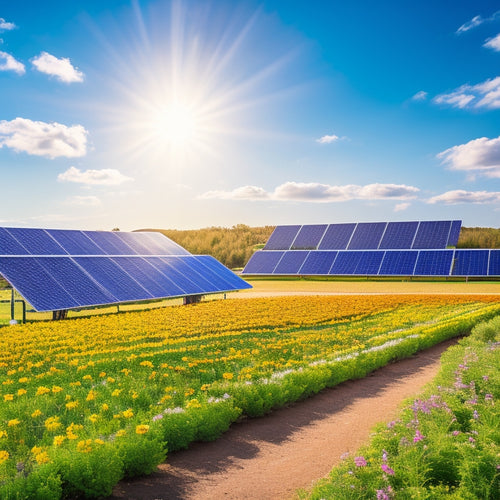
Track and Boost Your Business's Solar Energy Output
Share
By maximizing and optimizing your business's solar energy output, you can increase your return on investment by up to 25%. To get started, focus on regular maintenance, monitoring energy generation rates, and tracking efficiency ratios. Implement a monitoring system that provides real-time energy production tracking, customizable alerts, and inverter-level monitoring. This will help you pinpoint areas of inefficiency and optimize energy harvesting potential. By leveraging data analytics, you can uncover hidden patterns and correlations in energy output, allowing you to make data-driven decisions. Now, discover how to realize the full potential of your solar energy system.
Key Takeaways
• Implement monitoring systems to track energy generation rates, efficiency ratios, and inverter performance for optimal system function.
• Optimize panel angle and orientation to capture maximum energy, and use high-efficiency inverters to minimize energy loss.
• Utilize data analytics to uncover hidden patterns, pinpoint inefficiencies, and apply machine learning algorithms for energy forecasting and anomaly detection.
• Set customizable alerts and notifications for real-time performance updates, and trigger warnings based on energy threshold warnings.
• Scale up energy storage systems and employ advanced monitoring systems to meet growing energy demands and optimize energy distribution.
Understanding Solar Panel Performance
Your solar panel system's performance is measured by its ability to convert sunlight into electrical energy, with efficiency ratings varying between 15% to 20% depending on the panel's quality and technology.
It's important to separate fact from fiction when it comes to solar myths. One common misconception is that solar panels require frequent cleaning to maintain efficiency. However, research shows that dirt buildup has a minimal impact on energy output.
In reality, regular panel maintenance is vital to optimize performance. By scheduling regular inspections and performing routine cleaning, you can make sure your system operates at its best.
Don't let solar myths hold you back from maximizing your energy output. By understanding the facts and prioritizing maintenance, you'll be well on your way to optimizing your solar panel system's performance.
Essential Features to Monitor
To optimize your solar energy output, you need to keep a close eye on key performance indicators.
You'll want to monitor your energy generation rate to identify trends and anomalies.
Energy Generation Rate
Solar panels' energy generation rate is a vital metric that directly impacts your business's bottom line, as it determines the amount of clean energy produced and fed back into the grid. You need to monitor this metric to guarantee your solar energy system is functioning at its best.
Energy forecasting helps you anticipate your energy generation rate, allowing you to adjust your energy usage and sales accordingly. With grid parity, where the cost of solar energy equals or is less than traditional energy sources, maximizing your energy generation rate is essential.
Panel Performance Metrics
Monitoring panel performance metrics is crucial to optimize energy generation, as even slight deviations from ideal levels can greatly impact your business's bottom line. You need to keep a close eye on key performance indicators to make certain your solar panels are operating at maximum efficiency.
Here are the essential features to monitor:
- Efficiency Ratio: Compare your system's actual energy output to its theoretical maximum output.
- Temperature Coefficient: Track how temperature fluctuations affect your panel's performance.
- Inverter Performance: Monitor inverter efficiency, as it directly affects your system's overall energy output.
- Shading and Reflection Losses: Identify areas where shading or reflection might be reducing energy generation.
- Solar Certifications and Energy Audits: Confirm compliance with industry standards and regulations, and identify opportunities for improvement through regular energy audits.
System Uptime Tracking
You need to track system uptime to guarantee that your solar energy system is generating power when it's supposed to, as even brief periods of downtime can greatly impact your business's energy output.
By monitoring system uptime, you can identify areas for improvement and optimize your system's performance. This involves tracking key performance indicators such as system reliability and downtime analysis.
With real-time data, you can pinpoint issues and take corrective action to minimize downtime. This guarantees that your system operates at maximum capacity, maximizing your energy output and reducing losses.
Choosing the Right Monitoring System
Your facility's energy production relies heavily on the accuracy and reliability of its monitoring system, which is why selecting the right one is essential to optimizing your solar energy output.
When choosing a monitoring system, consider the following key factors:
-
System Compatibility: Guarantee the system is compatible with your existing infrastructure and equipment.
-
Cost Benefits: Calculate the potential cost savings of a monitoring system, including reduced maintenance and increased energy production.
-
Data Granularity: Choose a system that provides detailed, real-time data on your energy production.
-
Customizable Alerts: Opt for a system that allows you to set custom alerts for performance issues or anomalies.
-
Scalability: Select a system that can grow with your facility's expanding energy needs.
Inverter-Level Monitoring Benefits
By drilling down to the inverter level, you can uncover hidden inefficiencies and pinpoint performance bottlenecks that might be obscured by system-wide monitoring. This granular approach enables you to identify underperforming inverters, optimize their operation, and maximize energy production.
Inverter-level monitoring allows you to detect issues like faulty or underperforming strings, and take corrective action to minimize energy losses. With inverter fine-tuning, you can fine-tune your system integration, ensuring that each component works in harmony to deliver peak performance.
Real-Time Energy Production Tracking
As you implement real-time energy production tracking, you'll be able to monitor your energy generation in real-time, analyzing performance trends to identify areas for improvement.
This detailed insight enables you to pinpoint system anomalies, allowing for swift issue resolution and minimizing energy losses.
Monitor Energy Generation
Real-time energy production tracking allows you to monitor your solar panels' performance in real-time, providing instant visibility into your energy generation.
This feature enables you to:
- Track your energy output in real-time, guaranteeing you're meeting your energy goals
- Identify underperforming panels and optimize their performance
- Make data-driven decisions to increase energy production
- Guarantee grid parity by optimizing your energy output to match grid electricity prices
- Use energy forecasting to predict and prepare for changes in energy demand
Analyze Performance Trends
You can identify trends and patterns in your solar energy production by analyzing your energy generation data over time, enabling you to pinpoint areas for improvement and optimize your system's performance.
By conducting regular energy audits, you can identify inefficiencies and opportunities for improvement.
Data visualization tools can help you make sense of your energy generation data, allowing you to quickly identify trends and patterns. This enables you to make data-driven decisions to improve your system's performance.
With real-time energy production tracking, you can monitor your system's performance in real-time, making adjustments as needed to maximize energy output.
Identify System Anomalies
By monitoring your solar energy system's performance in real-time, you can swiftly detect anomalies that might be hindering peak energy production. This allows you to identify and address system faults and performance degradation issues promptly.
Some common anomalies to look out for include:
- Unexpected drops in energy output
- Inconsistent performance across different sections of the system
- Unusual temperature readings from individual panels
- Deviations from expected energy production patterns
- Inverter or other equipment malfunctions
Identifying Energy Loss Causes
At least 20% of a solar panel's energy output is typically lost due to various inefficiencies, and identifying these energy loss causes is essential to optimizing your system's performance. You can't fix what you don't know, so it's vital to detect and address energy loss causes.
Thermal imaging and energy auditing are essential tools in identifying energy loss causes. Thermal imaging helps you visualize temperature anomalies, while energy auditing provides a detailed analysis of your system's energy consumption. By using these tools, you can pinpoint issues such as faulty inverters, dirty panels, or loose connections, and take corrective action.
Maximizing Energy Harvesting Potential
To maximize energy harvesting potential, optimizing system design and configuration is essential. Even slight deviations from ideal conditions can greatly impact energy yields. You want to guarantee your solar energy system is running at peak performance to minimize the climate impact of your business.
Here are key strategies to contemplate:
- Optimize panel angle and orientation to match your location's solar radiation patterns.
- Insure proper energy storage system sizing to capture excess energy generated during the day.
- Select high-efficiency inverters to minimize energy loss during conversion.
- Implement a monitoring system to track performance and identify areas for improvement.
- Regularly clean and maintain your solar panels to prevent energy losses due to dirt and debris buildup.
Customizable Alerts and Notifications
As you monitor your business's solar energy output, you'll want to stay informed about performance fluctuations and potential issues. That's where customizable alerts and notifications come in, enabling you to set specific energy threshold warnings, receive real-time performance updates, and trigger custom notifications based on your unique needs.
Energy Threshold Warnings
You set energy threshold warnings to trigger customizable alerts and notifications when your solar energy output falls below or exceeds predetermined levels, ensuring prompt action to optimize performance. This feature enables you to define energy limits that, when breached, initiate warning protocols. These protocols can be tailored to your specific needs, ensuring you're always informed and in control.
Some examples of energy threshold warnings include:
- Low energy output warnings during peak sun hours
- High energy output warnings during periods of high demand
- Deviation warnings for unexpected changes in energy output
- Alerts for energy output below a certain percentage of capacity
- Notifications for energy output exceeding predetermined safety levels
Real-time Performance Updates
How do you stay on top of your solar energy output's minute-by-minute fluctuations to maximize performance and efficiency?
With real-time performance updates, you can monitor your system's output in real-time, ensuring peak energy production. Customizable alerts and notifications keep you informed of any deviations from expected performance, enabling swift corrective action.
Data visualization tools provide a clear, concise view of your system's performance, allowing you to identify trends and patterns. This level of transparency is critical for system reliability, as it enables you to pinpoint potential issues before they impact energy production.
Custom Notification Triggers
Custom notification triggers enable you to set specific, data-driven thresholds for alerts and notifications, ensuring you're informed of performance deviations that require attention. This means you can focus on what matters, without being overwhelmed by unnecessary alerts.
With custom triggers, you can avoid alert fatigue and notification overload, ensuring that you're only notified when it counts.
Here are some examples of custom notification triggers you can set:
- Production drops below 90% of expected output
- Energy consumption exceeds 110% of historical average
- Inverter temperature exceeds 75°C
- Power output fluctuates by more than 5% within a 10-minute period
- System downtime exceeds 30 minutes
Data Analytics for Energy Optimization
By leveraging advanced data analytics, businesses can uncover hidden patterns and correlations in their solar energy output, pinpointing areas of inefficiency and opportunities for optimization. You'll be able to identify trends in energy production, consumption, and storage, enabling data-driven decisions to maximize your solar energy output.
Machine learning algorithms can be applied to energy forecasting, predicting energy demand and adjusting your energy strategy accordingly. With real-time monitoring and analysis, you can detect anomalies, optimize energy usage, and reduce energy waste.
Scalable Solutions for Growing Businesses
As your business expands, you'll need scalable solutions that can adapt to increasing energy demands, ensuring uninterrupted power supply and minimizing downtime. This is particularly vital for companies committed to green initiatives, where solar energy output is a key performance indicator.
To support your business expansion, consider the following scalable solutions:
-
Modular solar panel arrays that can be easily expanded or reconfigured as needed
-
Energy storage systems that can be scaled up to meet growing energy demands
-
Advanced monitoring systems that provide real-time data and alerts for efficient energy management
-
Cloud-based data analytics platforms that can handle increasing data volumes
-
Integrated energy management systems that optimize energy distribution and minimize waste
Frequently Asked Questions
How Do I Ensure My Monitoring System Is Compatible With My Solar Panels?
You'll want to confirm that your monitoring system is compatible with your solar panels by verifying the panel configuration and energy efficiency metrics match, then integrate the system to track performance and optimize energy production.
Can I Integrate My Monitoring System With Existing Business Management Software?
You can integrate your monitoring system with existing business management software using API integration, enabling seamless data exchange and advanced data analytics to optimize your operations and maximize your solar energy output.
How Often Should I Calibrate My Monitoring System to Ensure Accuracy?
As you navigate the precision landscape of monitoring systems, you'll need to chart a calibration schedule to combat sensor drift, ensuring your data remains a beacon of accuracy, shining bright like a guiding star in the darkness of inaccuracy.
Are Monitoring Systems Secure From Cyber Threats and Data Breaches?
You need to guarantee your monitoring system's security: implement robust encryption methods to safeguard data, regularly assess network vulnerabilities, and conduct penetration testing to prevent cyber threats and data breaches.
Can I Monitor My Solar Energy Output Remotely Using a Mobile App?
You're probably familiar with tracking your fitness goals on your smartwatch; similarly, you can monitor your solar energy output remotely using a mobile app, ensuring real-time energy tracking and efficient remote monitoring.
Related Posts
-

Solar Energy Storage Options for Homes
When considering solar energy storage options for your home, you'll find several effective solutions. Battery systems...
-

Energy-Efficient Home Upgrades for Cost Reduction
To reduce costs with energy-efficient home upgrades, focus on essential improvements like smart thermostats, energy-e...
-

High-Performance Solar Solutions for Sustainable Living
High-performance solar solutions are your gateway to sustainable living, maximizing energy efficiency while considera...


